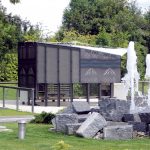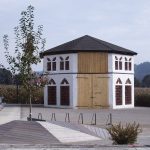Hügelland östlich von Graz, Styria, Austria
In the framework of a LEADER community initiative in 2000 in the downs east of Graz originally 15, now 24 municipalities joined together in a regional alliance to mutually form their future. The project area encompasses a total of approx. 28 000 inhabitants. The regional development concept is basically targeted on taking advantage of the favourable position in the immediate vicinity of the Styrian capital for the economic stimulation in the areas of tourism, local recreation and marketing especially in the agricultural areas and at the same time to preserve and emphasize the independent identity of the region.
Due to its scenic appeal these downs east of Graz have always been a local recreation area for the state capital. Supplying the close centre with agricultural products is an important and developable marketing potential for the rurally influenced farming. The convenient transport connections make it possible for commuters to settle in the region with relatively short journeys to the city. This has lead especially in the municipalities close to Graz to a strong drive in settlement.
The idea of regional market places was created, and in the meantime in the great part realised, as a symbol, a distinctive outer characteristic and real project to point out the regional identity and as an area of action for communal activities, marketing of agricultural products and tourist information: by four such market places in the municipalities Vasoldsberg, Kainbach bei Graz, St. Margarethen an der Raab and Laßnitzhöhe, that have each as „gateways“ been set up on the important access roads to Graz. The form of a regionally typical octagonal barn was chosen that forms the centre of the regional market place. By involving professional regional planners and architects the highly discerning new village centres and identity characteristics were created whose functionality has already often been proven.
In the project „Pleasure Region Downs“ the marketing of regional products (bread, mixed fruits) is specifically emphasized. It is based on the international „Slow Food Initiative” that especially emphasizes the deliberate use of high value food products. The very welcoming approach should be emphasized of aligning the whole region to this ideal aim and with it the vitalization of the regional identity.
Sankt Margarethen an der Raab offers special and architectural highlights. After the loss of several facilities for the provision of basic supplies (shopping possibilities, catering) a multifunctional centre is being created in the immediate vicinity of the regional market place in the neighbourhood of the so-called downs of inter-regional importance and therefore a new village focus. It is especially notable that a European wide architect competition was used as a basis. The works that were submitted had to take into consideration a modern old people’s home built several years ago that, with its 60 flats, is also of regional importance.
Also the individual cases where efforts were made to re-use empty historical buildings deserve recognition. For example in the municipality of Kainbach a project to preserve and re-use old farms and castles was brought about. The municipality at its own cost built an appropriately designed factory for the oldest fire engine producer in Austria and rented it to them.
The greatest challenge undoubtedly for an altogether enduring regional development of the downs east of Graz is the directed control of village and municipal construction. The very active persons responsible in the municipal parliament should achieve the preservation of those municipalities and villages that are subject to an especially strong drive in settlement with a goal oriented building land policy.
The downs east of Graz impresses especially with its exemplary and excellent achievements in commercial areas. The successful efforts should be particularly mentioned to realise measures in the wake of the capital Graz for strengthening the regional identity and added value in the areas of self marketing, leisure and recreation.
Evaluated: 2008





